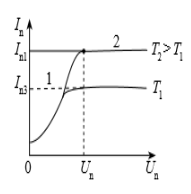The article analyzes the features of the methodology for conducting classes on the topic of electric current in a vacuum in a physics course, in secondary schools.
Key words: electron emission, vacuum, semiconductor, ion, anode, cathode, diode.
Physics in secondary school is a system of knowledge in physics, which provides the formation of fundamental scientific concepts, the assimilation of the basic laws of physics and theories, as well as an understanding of the methods of physics. This system provides students with polytechnic training, directly arising from the content of physics as a science, develops experimental skills and abilities to apply their knowledge to the consideration of a wide range of natural and technological phenomena and the solution of practically important problems.
In studying this topic, students will become familiar with the fundamentals of the physics of electronics and with its various applications in new technology. An increase in the level of presentation of electronics issues is achieved not due to the inclusion of new issues in the program, but as a result of a deeper consideration of the mechanism of the studied phenomena.
In the process of presenting educational material, it is recommended to apply a unified methodological approach; identify the nature of charge carriers, the nature of their movement in various environments, consider current-voltage characteristics, explain the laws under study on the basis of electronic concepts, highlight general laws and specific features of current in various environments, consider the structure and principle of operation of various electronic, ionic and semiconductor devices, and their technical applications.
You should rely only on a minimum of basic concepts — an electric field and free charge carriers. For technical applications, it is recommended to consider the simplest examples, but those that will help students imagine the most important applications of electronics.
All educational material on electric current in a vacuum consists of three parts: electron emission, laws of current in a vacuum and electric vacuum devices.
The study of current in a vacuum in high school is based on the classical electronic theory. To understand electrical phenomena in a vacuum, one must first of all master the phenomenon of electron emission. The importance of this phenomenon and the operation of electr vacuumdevices has led to the separation from the general electronics of its section — cathode electronics, the subject of which is the study of electron emission.
In presenting the problems of electron emission, it is advisable to widely use the analogy between this phenomenon and the evaporation of a liquid, considering electron emission as the evaporation of electrons from a metal. Accordingly, the work function of electrons can be introduced by analogy with the heat of vaporization of a liquid. The heat of vaporization must be related to one molecule. Consider the work function table for some metals. After that, you can consider the reasons for keeping the electrons in the metal.
For electron emission, it is necessary that the electrons in the metal have an energy sufficient to accomplish the work function. At room temperature, the energy of the overwhelming majority of electrons in a metal is much less than is necessary to perform this work; therefore, under normal conditions, electron emission is practically not observed. In order to fly out of the metal, electrons must receive additional energy. Depending on how the energy is communicated to the electrons or in what way they act on the cathode, the following types of electron emission are distinguished: thermionic emission caused by heating of the cathode; photoelectron emission arising from radiation; secondary electron emission caused by electron impacts on the cathode; electron emission due to impacts of heavy particles on the cathode.
The concept of the intensity of electron emission from the cathode is introduced, which is determined by the number of electrons emitted from the cathode per unit time. The sharp increase in the intensity of electron emission with increasing cathode temperature is confirmed by experiment with a demonstration diode. In the topic «Electric current in a vacuum», only the basic, relatively simple and understandable devices for students are studied: a diode, a triode.
To study the electric current in a vacuum, two electrodes are placed in a glass or metal flask at a certain distance from each other. The air must be evacuated so that molecules do not collide when moving between the electrodes. For this, the residual air pressure in the flask must be within p ≫ 10– 13 mm Hg.
We will call one of the electrodes the anode (A) and connect it to the positive pole of the source. The second will be the cathode (C) and connect it to the negative pole of the source (Fig. 1).

Fig. 1
When a voltage is applied between the anode and cathode, a sensitive galvanometer connected to the circuit will indicate the absence of current in the circuit. This means that in a vacuum there are no charged particles that carry current.
For charged particles to appear, you need to heat the cathode using a special heater

The heater is made in the form of a spiral, and an electric current is passed through it.
Thermoelectric emission is the emission of electrons by solid or liquid bodies when they are heated. For the electric current in the evacuated gas discharge tube, thermionic emission from the heated cathode is of importance. The electrons emitted by a heated body are called thermionic electrons , and the body itself is called an emitter . Thermionic emission is the most widespread in electronic devices.
When the cathode is heated, the electrons escaping from it are affected by the electric field between the anode and the cathode. As a result, electrons move from the cathode to the anode with acceleration. A galvanometer connected to the circuit detects the presence of current.
Now connect the anode to the negative side of the current source and connect the cathode to the positive side. In this case, the galvonometer needle does not deviate, i.e. no current flows through the circuit.
Electric current in a vacuum consists of an ordered flow of electrons.
Vacuum is such a degree of rarefaction of a gas at which one can neglect collisions between its molecules and assume that the mean free path exceeds the linear dimensions of the vessel in which the gas is located. The conductivity of the interelectrode gap in a vacuum state is called an electric current in a vacuum.
A vacuum lamp, consisting of an anode and a cathode, is called a two-electron vacuum tube — a diode.
The properties of any electronic device are characterized by its current-voltage characteristic, i.e. the dependence of the current passing through the device on the voltage applied to it.
To study the current-voltage characteristic of the diode, a constant voltage of 4 V is applied to its heater. As a result, the hot heater maintains a constant temperature T1. When the voltage between the anode and cathode is zero, electrons are knocked out of the hot cathode and form an electron cloud around the cathode. With an increase in the anode voltage, the electrons in the electron cloud begin to scatter. Here, with increasing voltage, the anode current also increases (Fig. 2).

Fig. 2
In the current-voltage characteristic, this falls on region 1. Then, the increase in voltage does not significantly affect the increase in the anode current, and in the characteristic it falls on region 2. At this time, all electrons leaving the cathode reach the anode, and the anode current remains unchanged. The anode current at this time is called the saturation current.
If we repeat the experiment with a 6 V heater voltage, its temperature will be T2. This will increase the saturation current. As can be seen from the characteristics, the dependence of the current on the voltage is nonlinear. In area 1 of the characteristic, the dependence of the current strength on the voltage obeys the following pattern

This formula is called the Boguslovsky-Langmuir formula.
Before the advent of high-power semiconductor diodes, vacuum diodes were used to rectify alternating current.
The current-voltage characteristic of a vacuum diode is easily obtained from the data of the corresponding demonstration experiment. In this case, the study of the dependence of the current strength on the voltage should begin with a demonstration of the saturation current section, showing the most distinctive feature of this dependence in comparison with a similar dependence for metal conductors. It is necessary to draw the attention of students to the unusualness of the phenomenon under consideration. After that, it should be shown that this is true only for a certain voltage range, and then consider the current-voltage characteristic in the section where the current increases with increasing voltage. Students can be explained only the general nature of this dependence on the basis of the concept of a pro-space charge — an electron cloud.
Continuing the analogy between emission and evaporation, it should be shown that the dynamic equilibrium, which is established between the number of electrons emitted every second from the cathode into the electron cloud, and the number of electrons falling back from the cloud to the cathode, is similar to the dynamic equilibrium that occurs between the liquid and its saturating steam.
The study of the laws of electronic phenomena in a vacuum is directly related to the consideration of the technical applications of these phenomena — electrovacuum devices, so that it gives the opportunity to acquaint students with the main types of these devices and so that their study allows them to consider the application of the basic phenomena and laws of current in a vacuum.
References:
- Методика преподавания физики. Пособие для учителей. Под редакцией А. В. Усовой. Москва «Просвещение» 1990.
- Осадчук П. А. Методика преподавания физики. Дидактические основы. Киев — Одесса. 1984.
- Бугаев А. И. Методика преподавания физики в средней школе: Теоретические основы. — М.: «Просвещение», 1981.







